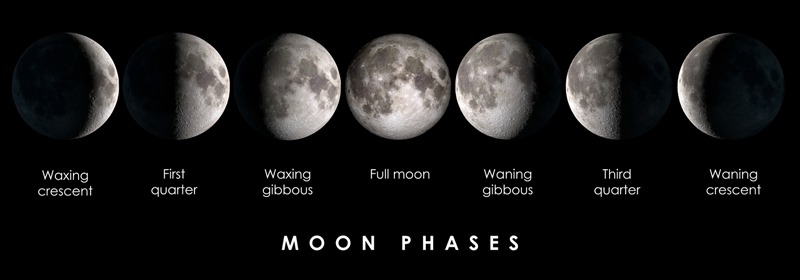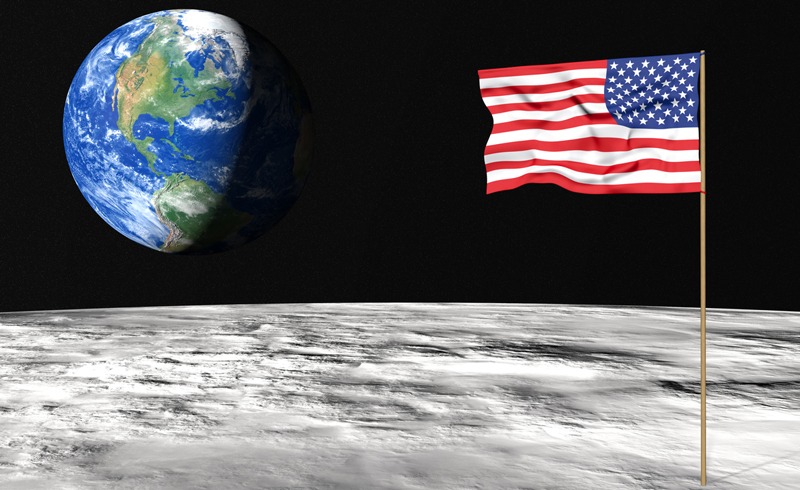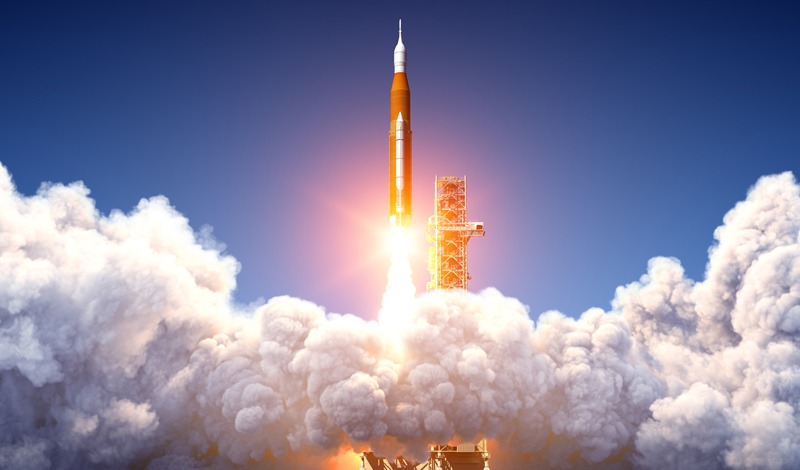Earth has only one Moon, a stony, cratered body about a fourth its size that orbits it at a distance of 238,855 miles. The Moon is the only natural satellite of the Earth and the closest massive celestial body.
It is the brightest celestial body following the Sun and is represented by the symbol ☽. It has been known since prehistoric times, and its English name is derived from Germanic and Old English. [1]
The Moon’s stark beauty has piqued people’s interest and created a rich cultural and metaphorical legacy throughout history. The Moon was once considered as a divinity, and its dominance was exemplified by its rhythmic power over the cycle of female fertility and the tides. The Moon’s power to infuse spells with magic, convert humans into monsters, and send people’s behavior wobbling perilously between sane and madness (from the Latin luna, “Moon”) is told in ancient literature and folklore.
Even before Apollo astronauts in orbit above the Moon sent back images of the reality that human vision has been witnessing for the first time, poets and composers were invoking the Moon’s romantic charms and its ugly side, and writers of fiction were leading their readers on theoretical lunar journeys.
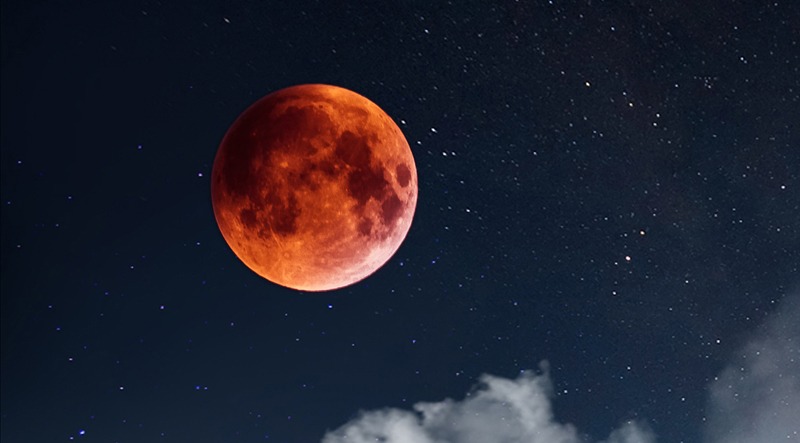
full Lunar eclipse
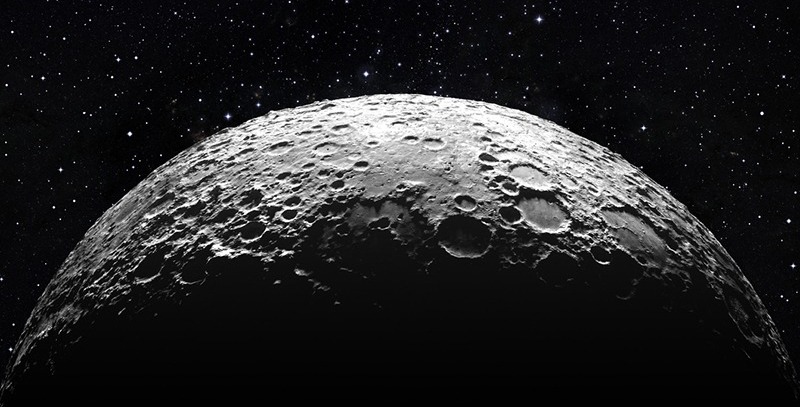
half Moon surface and starry space
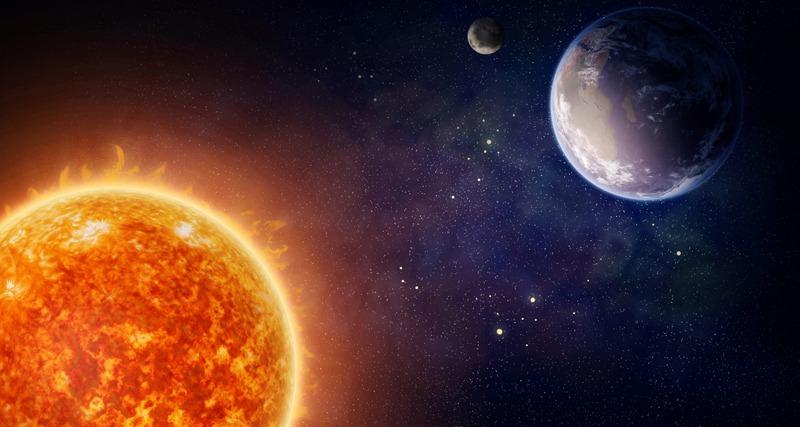
Moon in between the Earth and the Sun
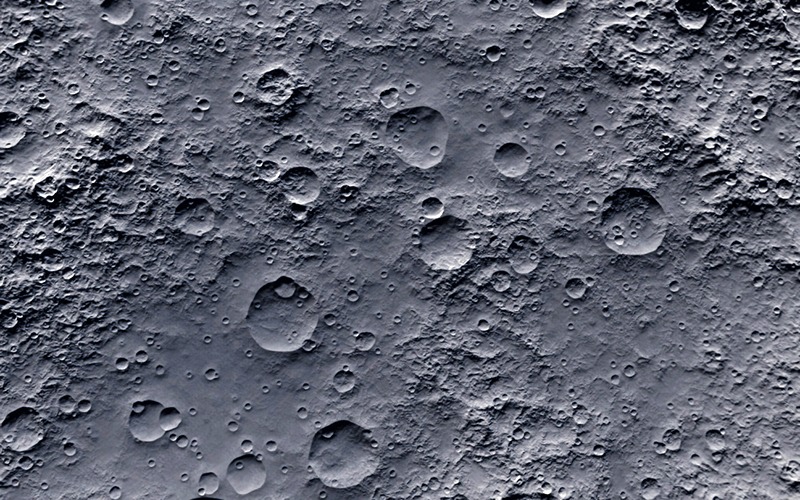
Lunar Surface
The nature and origin of the Moon have been the focus of decades of observation and scientific inquiry. Early studies of the Moon’s position and motion resulted in calendars and the prediction of tides. The Moon was the first new world where humans set foot, and the data collected from those expeditions, combined with data collected by remote-sensing observations and automated spacecraft, has resulted in a level of understanding of the Moon that exceeds that of any other cosmic body except Earth itself.
Even though many uncertainties concerning the Moon’s structure, composition, and history remain, it is obvious that the Moon holds the answer to understanding the Earth’s and solar system’s origins. Furthermore, the Moon remains a prime location for humankind’s first settlements beyond Earth orbit due to its proximity to Earth, its rich propensity as a source of energy and materials, and its qualifications as a place to learn how to work and live in space and a laboratory for planetary science for extended periods.
Where It Got Its Name
The Moon, with a capital M, is the most common English proper name for the Earth’s natural satellite. The noun moon originates from Old English mōna, which comes from Proto-Germanic *mēnōn, which stems from Proto-Indo-European *mēnsis, meaning “month” (from prior *mēnōt, genitive *mēneses), which may be linked to the verb “measure” (of time).[2]
Luna /ˈluːnə/ is occasionally used in scientific writing, particularly science fiction, to identify the Earth’s satellite from others, while “Luna” has been used in poetry to suggest the Moon’s personification. Cynthia is a poetic name for the Moon personified as a goddess; however, it is uncommon, while Selene (meaning “Moon”) is the Greek goddess of the Moon.
The common English term for the Moon is “lunar,” which comes from the Latin word lūna, which means “Moon.” The adjective selenian, from the Greek word for Moon, σελήvη selēnē, and used to define the Moon as a world rather than a celestial object, is uncommon, although it’s equivalent selenic was once a rare synonym now almost usually alludes to the chemical element selenium. The prefix seleno-, as used in selenography or the study of the Moon’s physical properties, and the element name selenium are both found in the Greek word for the Moon.
Artemis, the Greek goddess of the hunt and the wilderness, was also known as Cynthia, after her mythological home on Mount Cynthus. She was identified with Diana, the Roman goddess of the Moon, whose sign was the Moon and widely considered the goddess of the Moon. Technical words for lunar orbits such as apolune, pericynthion, and selenocentric mirror these names – Luna, Cynthia, and Selene.
Distinctive Features
The Moon is a sphere-shaped rocky body with a possibly small metallic core that orbits Earth in a somewhat eccentric orbit at a distance of roughly 384,000 kilometers (238,600 miles). It has an equatorial radius of 1,738 kilometers (1,080 miles) and a slightly flattened shape that bulges slightly in the Earth’s direction.
It has surface mass concentrations, known as mascons, cause the Moon’s gravitational field to ramp up over local areas. Its mass distribution isn’t uniform—the center of mass is displaced roughly 2 km (1.2 miles) towards Earth relative to the center of the lunar sphere.[1]
Although the Moon lacks the same global magnetic field as Earth, some surface rocks possess remanent magnetism, indicating the presence of one or more past magnetic activity episodes. The Moon currently has very little seismic activity and very little heat transfer from within, indicating that most internal activity has long since stopped.
Scientists today believe that the Moon was subjected to intense heating more than four billion years ago, most likely due to its formation, resulting in its chemical separation or differentiation into a less solid crust and a denser underlying mantle. The second event of heating—this time caused by internal radioactivity—occurred hundreds of millions of years later, resulting in volcanic lava outpourings. The Moon’s density is 3.34 grams per cubic cm, similar to the Earth’s mantle.[1]
Because of its small mass and size, the Moon’s surface gravity is about one-sixth of the planet; it has so little atmosphere that any gases on the surface travel without colliding. Countless entities ranging in size from asteroids to small particles have crashed and cratered the Moon due to the lack of an air shield to shield the surface from bombardment. This has resulted in forming a debris layer, or regolith, made up of rock fragments of all sizes, down to the tiniest dust.
The greatest impacts in the past created vast basins, many of which were later partially filled by massive lava floods. These vast dark plains, known as maria (singular mare), are visible from Earth with the naked eye.
The two primary types of lunar territory are the black maria and the brighter highlands, whose constant patterns numerous people recognize as the “man in the moon.” The mascons are areas where extremely dense lavas erupted from the mantle and inundated basins. Because the never-ending rain of impacts has worn all lunar formations, lunar mountains, usually found along the margins of ancient basins, are high but not sharp-peaked or steep.
Lunar Surface
The moon is said to be composed of cheese in children’s stories, although like with all heavenly bodies, rock is the more accurate constituent. Dead volcanoes, lava flows, and impact craters litter the moon’s surface, some of which are visible to the unaided eye.
Early astronomers assumed the black parts of the moon were oceans by early astronomers; therefore, they were given the name mare, which means “seas” in Latin (maria when there are more than one). They’re oceans because they’re made up of pools of solidified lava rather than water.
The moon’s center was once molten enough to form volcanoes, but it rapidly cooled and hardened. When huge enough asteroids smashed through the surface, lava erupted from the crust.
The moon’s surface is littered with asteroids, which you can view with a telescope during most moon phases. All of the moons and planets experienced a period of tremendous bombardment early in the solar system’s history, as the last of the massive rocks were trapped by gravity and fell against their surface.
Plate tectonics and erosion hid much evidence from this period on Earth, while the atmosphere aided in burning up several smaller culprits before they reached the surface. On the other hand, the moon lacks all three of these cleaning elements, preserving the solar system’s past on its surface.
Of course, the craters on the moon were not all created during the time of severe bombardment, which ended some 3.8 billion years ago. Asteroids of all sizes continued to batter the Earth at a reduced rate, resulting in craters on top of lava flows and overlapping craters.
The moon’s crust is composed of a rocky surface covered in regolith. Asteroids and meteorites crash with the Earth’s surface; they shatter it into tiny fragments, capturing imprints (like Neil Armstrong’s iconic footprint) in incredible detail.
The thickness of the moon’s crust ranges from 38–63 miles (60–100 kilometers). The surface regolith can range from 10 feet (3 meters) in the maria to 66 feet (20 meters) in the highlands.[3]
Lunar Mountains [4]
The Latin word mons is used to describe lunar mountains (plural montes).
Mountain Ranges [4]
Name | Latitude/Longitude | Diameter | Name Origin |
Montes Agricola | 29.06°N 54.07°W | 141 km | Georgius Agricola, scientist |
Montes Alpes | 48.36°N 0.58°W | 281 km | The Alps, Europe |
Montes Apenninus | 19.87°N 0.03°W | 401 km | The Apennine Mountains, Italy |
Montes Archimedes | 25.39°N 5.25°W | 163 km | Named after nearby crater Archimedes |
Montes Carpatus | 14.57°N 23.62°W | 361 km | The Carpathian Mountains, Europe |
Montes Caucasus | 37.52°N 9.93°E | 445 km | The Caucasus Mountains, Europe |
Montes Cordillera | 17.5°S 79.5°W | 574 km | Spanish for "mountain chain" |
Montes Haemus | 17.11°N 12.03°E | 560 km | Greek name for the Balkan Mountains |
Montes Harbinger | 26.89°N 41.29°W | 90 km | Harbingers of dawn on the crater Aristarchus |
Montes Jura | 47.49°N 36.11°W | 422 km | The Jura Mountains, Europe |
Montes Pyrenaeus | 14.05°S 41.51°E | 164 km | The Pyrenees Mountains, Europe |
Montes Recti | 48.3°N 19.72°W | 90 km | Latin for "straight range" |
Montes Riphaeus | 7.48°S 27.60°W | 189 km | Greek name for the Ural Mountains, Russia |
Montes Rook | 20.6°S 82.5°W | 791 km | Lawrence Rook, astronomer |
Montes Secchi | 2.72°N 43.17°E | 50 km | Named after nearby crater Secchi |
Montes Spitzbergen | 34.47°N 5.21°W | 60 km | Named after German for "sharp peaks" and for resemblance to the Spitsbergen islands |
Montes Taurus | 27.32°N 40.34°E | 172 km | Taurus Mountains, Asia Minor |
Montes Teneriffe | 47.89°N 13.19°W | 182 km | Tenerife island |
Most Prominent Lunar Craters [4]
Impact craters account for the vast majority of these landforms. The International Astronomical Union is in charge of crater nomenclature, and this list only includes features that the scientific organization officially recognizes.
Crater | Coordinates | Diameter (km) | Approval Year | Eponym |
Bailly | 66.82°S 68.9°W | 300.56 | 1935 | Jean Sylvain Bailly (1736–1793) |
Clavius | 58.62°S 14.73°W | 230.77 | 1935 | Christopher Klau Clavius (1537–1612) |
Humboldt | 27.02°S 80.96°E | 199.46 | 1935 | Wilhelm von Humboldt (1767–1835) |
Janssen | 44.96°S 40.82°E | 200.65 | 1935 | Pierre Jules César Janssen (1824–1907) |
Langrenus | 8.86°S 61.04°E | 131.98 | 1935 | Michel Florent van Langren (circa 1600–1675) |
Longomontanus | 49.55°S 21.88°W | 145.5 | 1935 | Christian Sørensen Longomontanus (1562–1647) |
Maginus | 50.03°S 5.98°W | 155.58 | 1935 | Giovanni Antonio Magini (1555–1617) |
Petavius | 25.39°S 60.78°E | 184.06 | 1935 | Denis Petau (1583–1652) |
Schickard | 44.38°S 55.11°W | 212.18 | 1935 | Wilhelm Schickard (1592–1635) |
Vendelinus | 16.46°S 61.55°E | 141.21 | 1935 | Godefroid Wendelin (1580–1667) |
Lunar Maria [4]
Large, dark patches of the Moon are known as lunar maria (singular mare). They don’t have any water in them, but they’re thought to have been produced by molten rock erupting onto the surface from the Moon’s mantle.
Latin Name | English Name | Latitude | Longitude | Diameter (km) |
Mare Anguis | Serpent Sea | 22.6° N | 67.7° E | 150 |
Mare Australe | Southern Sea | 38.9° S | 93.0° E | 603 |
Mare Cognitum | Sea of Knowledge | 10.0° S | 23.1° W | 376 |
Mare Crisium | Sea of Crises | 17.0° N | 59.1° E | 418 |
Mare Fecunditatis | Sea of Fecundity | 7.8° S | 51.3° E | 909 |
Mare Frigoris | Sea of Cold | 56.0° N | 1.4° E | 1596 |
Mare Humboldtianum | Sea of Alexander von Humboldt | 56.8° N | 81.5° E | 273 |
Mare Humorum | Sea of Moisture | 24.4° S | 38.6° W | 389 |
Mare Imbrium | Sea of Showers | 32.8° N | 15.6° W | 1123 |
Mare Ingenii | Sea of Cleverness | 33.7° S | 163.5° E | 318 |
Mare Insularum | Sea of Islands | 7.5° N | 30.9° W | 513 |
Mare Marginis | Sea of the Edge | 13.3° N | 86.1° E | 420 |
Mare Moscoviense | Sea of Moscow | 27.3° N | 147.9° E | 277 |
Mare Nectaris | Sea of Nectar | 15.2° S | 35.5° E | 333 |
Mare Nubium | Sea of Clouds | 21.3° S | 16.6° W | 715 |
Mare Orientale | Eastern Sea | 19.4° S | 92.8° W | 327 |
Mare Serenitatis | Sea of Serenity | 28.0° N | 17.5° E | 707 |
Mare Smythii | Smyth’s Sea | 1.3° N | 87.5° E | 373 |
Mare Spumans | Foaming Sea | 1.1° N | 65.1° E | 139 |
Mare Tranquillitatis | Sea of Tranquility | 8.5° N | 31.4° E | 873 |
Mare Undarum | Sea of Waves | 6.8° N | 68.4° E | 243 |
Mare Vaporum | Sea of Vapors | 13.3° N | 3.6° E | 245 |
Oceanus Procellarum | Ocean of Storms | 18.4° N | 57.4° W | 2568 |
Lunar Valleys [4]
Valley | Coordinates | Dimension | Eponym | Crater |
Vallis Alpes | 48.5°N 3.2°E | 166 km | Latin name meaning “Alpine valley” | None |
Vallis Baade | 45.9°S 76.2°W | 203 km | Walter Baade | Baade |
Vallis Bohr | 12.4°N 86.6°W | 80 km | Niels Bohr | Bohr |
Vallis Bouvard | 38.3°S 83.1°W | 284 km | Alexis Bouvard | None |
Vallis Capella | 7.6°S 34.9°E | 49 km | Martianus Capella | Capella |
Vallis Inghirami | 43.8°S 72.2°W | 148 km | Giovanni Inghirami | Inghirami |
Vallis Palitzsch | 26.4°S 64.3°E | 132 km | Johann Palitzsch | Palitzsch |
Vallis Planck | 58.4°S 126.1°E | 451 km | Max Planck | Planck |
Vallis Rheita | 42.5°S 51.5°E | 445 km | Anton Maria Schyrleus of Rheita | Rheita |
Vallis Schrödinger | 67.0°S 105.0°E | 310 km | Erwin Schrödinger | Schrödinger |
Vallis Schröteri | 26.2°N 50.8°W | 168 km | Johann Hieronymus Schröter | Schröter |
Vallis Snellius | 31.1°S 56.0°E | 592 km | Willebrord Snell | Snellius |
Lunar Surface Chemical Composition [5]
The Temperature on the Moon
The Moon’s temperature ranges from scorching hot to icy cold according to where the Sun shines. Because the Moon has no appreciable atmosphere, it cannot insulate the surface or trap heat.
The Moon spins on its axis for around 27 days. Daytime lasts around 13 and a half days on one side of the Moon, then darkness for 13 and a half nights. The temperature on the Moon’s surface can reach 127 degrees Celsius (260 degrees Fahrenheit) when sunlight strikes it.
Temperatures can drop to minus 173 Celsius (minus 280 Fahrenheit) after the Sun sets. Due to lunar rotation, both the near and far sides of the Moon encounter sunlight every terrestrial month or lunar year, and temperatures fluctuate across the Moon.
The Moon tilts around 1.54 degrees on its axis, far less than the Earth’s 23.44 degrees. This means that the Moon does not experience seasons in the same way that Earth does. However, due to the tilt, certain areas near the lunar poles never experience daylight.[6]
Moon Formation
There are other hypotheses about how the Moon came to be, but new evidence suggests that it developed when a massive impact ripped a portion of the ancient molten Earth away, putting the raw materials for the Moon into orbit.
According to scientists, the impactor was around 10% of the Earth’s mass or nearly the size of Mars. Because the Moon and the Earth are so close in composition, scientists believe the collision happened roughly 95 million years after the solar system formed, give or take 32 million years. (The age of the solar system is estimated to be around 4.6 billion years.)
Based on models of planetary orbits within the early solar system and recently discovered discrepancies in the quantity of the element tungsten-182 identified in the Earth and the Moon, additional studies published in 2015 bolstered this notion.
Even though the massive impact scenario dominates the scientific debate, there are various additional theories regarding the Moon’s creation. According to a new theory, the Moon fissioned out of the Earth, the Earth may have grabbed the Moon, or the Earth may have taken the Moon from Venus.[7]
Earth-Moon System
It takes approximately three days for a spacecraft to reach the Moon, and you could fit around 30 Earths in the space between the Moon and our planet (that’s around the length of 4,133 Statues of Liberty!). Aside from its proximity to Earth, the Moon is huge in comparison to the planet—their masses are far larger than other natural satellites orbiting planets. As a result, the Moon and Earth have a significant gravitational attraction to each other, establishing a system with different traits and behavior.
Although the Moon is generally said to be orbiting Earth, the two entities orbit each other around a single center of mass. This location, known as the barycentre, is around 4,700 kilometers (2,900 miles) from Earth’s center.
Following Kepler’s equations of planetary motion, the barycentre, not the center of the Earth, takes an elliptical course around the Sun. The Moon’s phases and lunar and solar eclipses are caused by the orbital geometry of the Earth, Moon, and Sun.
Phases of the Moon
New, full, first quarter, and last quarter are the four primary phases of the Moon. When the Moon is flanked by the Sun and Earth, it forms a new moon, and the side of it that is in shadow faces Earth. The Moon is full when it is on the opposite end of Earth from the Sun, and the lit side of the Moon faces Earth.
When the Moon is at a 90-degree angle to the Sun when viewed from Earth, the first and last quarters occur when half the Moon is lighted. (Earth’s phases are reversed when seen from the Moon; for example, Earth is full whenever the Moon is new.)
Eclipse (Solar and Lunar)
Solar eclipse results from the Moon passing between the Earth and the Sun, and a lunar eclipse results from the Moon going by the Sun’s shadow thrown on Earth. Solar eclipses transpire during the new Moon, and lunar eclipses happen when the Moon is full.
Because the Moon’s orbit plane is inclined by about 5 degrees to that of the Earth’s orbit around the Sun (the ecliptic), eclipses do not occur every month. As a result, the Sun, the Earth, and the Moon are not always straight lines for new and full moons.
Lunar Distance
Due to the combined gravity of the Sun, Earth, and the planets, the distance between the Moon and Earth varies quite a bit. The Moon’s apogee—the greatest distance it travels from Earth in a revolution—ranged between roughly 404,000 and 406,700 km (251,000 and 252,700 miles) in the last three decades of the twentieth century, while its perigee—the closest it approaches Earth—ranged somewhere between 356,500 and 370,400 km (221,500 and 230,200 miles).
Tides
Tidal interactions, or cyclic deformations in everybody caused by the gravitational attraction of another, have slowed the Moon’s spin to the point where it now circles at the same pace as Earth and so always faces the same side. The Moon’s spin axis precesses concerning its orbital plane, as French astronomer Gian Domenico Cassini discovered in 1692. This means that its orientation changes slowly over time, tracing a cyclical course.
Orbit
According to Kepler’s second law, the Moon’s eccentricity causes it to travel faster in the section of its orbit closest to Earth and slower in the region farther away. When combined with the Moon’s steady spin rate, these speed changes produce an apparent oscillation, or libration, that allows an observer on Earth to view over half of the lunar surface over time.
The Moon does rock slightly back and forth in both latitude and longitude, and the observer’s vantage point varies with the Earth’s rotation. As a result of all of these motions, Earth can see over 59% of the lunar surface at any given time.
Solar eclipses, wherein the Moon passes between the Earth and the Sun, producing a moving shadow across the Earth’s sunlit surface, are similarly affected by orbital eccentricity. Observers right by the Moon’s dark inner shadow (umbra) path will view a total eclipse if a solar eclipse transpires when the Moon is near the perigee. When the Moon is approaching apogee, it does not completely cover the Sun; the ensuing annular eclipse is visible, with a narrow ring of the solar disk surrounding the Moon’s silhouette.
The Moon and Earth currently orbit the barycentre in 27.322 days, the Moon’s sidereal month or sidereal revolution period. The angle of illumination shifts around one degree per day since the entire system revolves around the Sun once a year; hence the time between one full Moon and the next is 29.531 days, the synodic revolution period or the synodic month of the Moon. As a result, throughout this synodic cycle, the Moon’s terminator—the line separating day and night—moves once around the Moon, exposing most areas to alternating periods of darkness and sunlight every approximately 15 Earth days.
Because of tidal interactions, the synodic and sidereal periods are slowly altering over time; despite tidal friction slowing Earth’s rotation, conservation of momentum mandates that the Earth-Moon system’s angular momentum remains constant. As a result, the Moon gradually retreats from Earth, causing both the day and month to become longer.
Extending this link back in time, both periods must have been hundreds of millions of years shorter—a supposition supported by observations of tide-related and daily growth rings in fossil corals.
The Moon has no seasons because its spin axis is practically perpendicular to the ecliptic plane (the plane of the Earth’s orbit around the Sun)—only 11/2 degrees from vertical. At the lunar poles, sunlight is constantly almost horizontal, resulting in perennially frigid and gloomy habitats at the bases of deep craters.[1]
Earth vs. Moon by the Numbers [8]
Motions of the Moon
The study of the lunar motions has been crucial to advancing knowledge about the Moon and the basics of celestial physics and mechanics. The Moon progressively advances eastward, rising later every day and going through its phases: new, first quarter, full, last quarter, and new again every month, much as the stars seem to move westward due to Earth’s daily rotation and annual motion around the Sun.
The long-running Chaldean, Chinese, and Mayan calendars were all efforts to reconcile these inexorable movements. Investigators have been looking for slight deviations from the anticipated motions since the Babylonian astrologers and Greek astronomers until today. In the late 17th century, English physicist Isaac Newton utilized lunar observations to construct his theory of gravitation, and he was able to demonstrate certain effects of solar gravity on the Moon’s motion.
The mathematical study of moon movements, both orbital and rotational, was progressing by the 18th and 19th centuries, fueled in part by the necessity for precise tables of the expected positions of celestial objects (ephemerides) for navigation. While theory evolved as data improved, multiple small and perplexing inconsistencies persisted. Some are caused by Earth’s rotation rate abnormalities, while others are caused by modest tidal impacts on Moon and Earth.
Space exploration necessitated a significant increase in precision, and the availability of new observational equipment and fast computers provided the means to do it. Analytic treatment, or the mathematical modeling of the Moon’s motions with a sequence of terms representing the gravitational effect of the Earth, the Sun, and the planets, was supplanted by approaches determined by direct numerical integration of the Moon’s equations of motion. Both strategies needed extensive observational input, although the latter resulted in increased prediction accuracy.
At the same time, radio and optical observations improved dramatically—retroreflectors placed on the lunar surface by Apollo astronauts enabled laser ranging of the Moon from Earth, and new radio astronomy techniques, such as very long baseline interferometry, allowed observations of celestial radio sources as the Moon occulted them. Scientists have been able to quantify variations in the Moon’s speed caused by terrestrial tidal momentum exchange thanks to these observations, which have expanded understanding of relativity theories and contributed to better geophysical knowledge of both the Earth and the Moon.[1]
Principal and Intermediate Phases of the Moon [9]
As the Earth and Moon’s orbits around the Sun fluctuate over the synodic month – every 29.53 days – these lunar phases shift regularly.
The Moon is tidally locked to the Earth’s gravity, preventing it from rotating and causing only one side of the Moon to face us at all times. This face of the Moon receives varying amounts of sunlight according to the Moon’s orbital position.
As a result, the sunlit section of this face, sometimes called the near side, can range from 0% during the new Moon to 100% during the full Moon. The lunar terminator, or the shifting line separating the night and daylit sides of the Moon, is the boundary between the illuminated portion of the Moon and its darker hemispheres. [9]
Lunar Interior
The Apollo missions and robotic spacecraft such as Galileo, Clementine, and Lunar Prospector, which studied the Moon in the 1990s, provided most knowledge on the lunar interior. Scientists have built a picture of the Moon as a layered structure with a low-density crust ranging from 60–100 km (40–60 miles) in thickness, covering a denser mantle that makes up the vast bulk of the Moon’s volume, based on all available data.
There is likely a little iron-rich metallic core near the center, with a maximum radius of 350 km (250 miles). The Moon’s core once had an electromagnetic dynamo similar to Earth’s, accounting for the remanent magnetism detected in some lunar rocks, but such internal activity appears to have halted on the Moon long ago.
Despite these advances in understanding, there are still significant uncertainties. For example, there appears to be no widely accepted explanation for the proof that the Moon’s crust is asymmetrical, with the maria largely on the near side. Natural samples dug from massive impact basins could help to answer these and other puzzles about lunar history.[1]
Lunar Explorations
Early Observations from the Earth
Some early humans thought the Moon was a mirror that mirrored Earth’s lands and seas, while others thought it was a bowl of fire; however, ancient Greek philosophers understood the Moon to be a sphere orbiting the Earth that reflected sunlight.
The Greeks also thought the black sections of the Moon were oceans, while the brilliant areas were land, which informed the current names for those regions—”terrae” and “maria,” Latin for lands and seas, respectively.
Galileo Galilei, a Renaissance astronomer, was the first to use a telescope to undertake scientific observations of the Moon, depicting a rough, mountainous surface in 1609, contrary to popular belief that the Moon was smooth.
The Space Race to the Moon
The Soviet Union launched the first spacecraft to collide with the Moon’s surface in 1959, returning the first visuals of the Moon’s far side. During the Cold War, this sparked a succession of uncrewed trips to the Moon’s surface by the Soviet Union and the U.S.
Many of the initial probes failed or were only partially successful. However, these early probes did relay information on the Moon’s geological history and surface throughout time. The U.S. launched the Ranger, Pioneer, and Surveyor missions, while the Soviet Union launched Luna and Zond probes.
In the 60s and 70s, the United States dispatched astronauts to the Moon’s surface and orbit. The Apollo 8 men orbited the Moon in 1968, making it the first crewed trip to the Moon.
Apollo 11 became the first-ever mission to land people on the Moon in 1969, succeeded by five more successful surface flights (plus one, Apollo 13, that didn’t make it to the Moon but returned safely to Earth). Humans have only ever visited the Moon as an extraterrestrial body.
The Apollo program brought back 842 pounds (382 kg) of soil and rocks for examination. Scientists are still studying the rocks, and fresh findings have been made as technology has advanced. Water was discovered in samples from Apollo 15, 16, and 17 in 2013, which was a surprising revelation given that prior tests had shown these rocks to be quite dry.
Throughout the 1960s and 1970s, the Soviet Union continued to pursue robotic lunar exploration. After several failed attempts with prior missions, Luna 16 became the first robotic lunar sample return expedition in September 1970.
Only two months later, the Soviets launched Lunokhod 1, the first robotic lunar rover. Lunokhod 2, launched in 1973, held the record for off-world driving distance for over 40 years until the Mars Opportunity, the long-running rover mission, beat it in 2014 after many years of driving.
Missions in the Modern Age
Lunar exploration of the U.S. spacecraft restarted in the 1990s after a more than decade hiatus.
Since then, many other countries and organizations, including the European Space Agency, Japan, India, China, and Israel, have joined the moon race. China is the only one to have successfully operated on the Moon’s surface; landers sent by the other two countries crashed.
Japan, Russia, and the United Arab Emirates, among others, are discussing future lunar expeditions.
Meanwhile, in 2019, President Donald Trump’s administration declared that NASA will be tasked with returning people to the Moon by 2024. The Artemis program would rely on international and commercial partners to support a long-term crewed exploration program fueled by NASA’s Space Launch System heavy-lift rocket.[6]
Lunar Missions [10]
This list includes the most significant successful lunar missions from the 1950s to the 2010s.
References
[1] James D. Burke, 2021. Moon. Britannica. Available at: https://www.britannica.com/place/Moon [Accessed November 2, 2021].
[2] Online Etymology Dictionary Editors. Moon (n.). Online Etymology Dictionary. Available at: https://www.etymonline.com/word/moon [Accessed November 2, 2021].
[3] Nola Taylor Redd, 2017. What is the Moon Made Of?. Space.com. Available at: https://www.space.com/19582-moon-composition.html [Accessed November 2, 2021].
[4] IAU Editors. Planetary Names: The Moon. Gazetteer of Planetary Nomenclature. Available at: https://planetarynames.wr.usgs.gov/Page/MOON/target [Accessed November 2, 2021].
[5] Stuart R. Taylor, 1975. Lunar Science: a Post-Apollo View. Oxford: Pergamon Press. p. 64. ISBN 978-0-08-018274-2.
[6] Tim Sharp, 2017. What is the Temperature on the Moon? Space.com. Available at: https://www.space.com/18175-moon-temperature.html [Accessed November 3, 2021].
[7] Charles Q. Choi, 2021. Moon facts: Fun information about the Earth’s moon. Space.com. Available at: https://www.space.com/55-earths-moon-formation-composition-and-orbit.html [Accessed November 3, 2021].
[8] NASA Planetary Science Communications Team. Earth’s Moon. NASA Science. Available at: https://solarsystem.nasa.gov/moons/earths-moon/by-the-numbers/ [Accessed November 3, 2021].
[9] Nine Planets Editors. Phases of the Moon. Nine Planets. Available at: https://nineplanets.org/moon/phases/ [Accessed November 3, 2021].
[10] NASA Science Public Engagement Team. Moon Missions. NASA Science. Available at: https://moon.nasa.gov/exploration/moon-missions/ [Accessed November 3, 2021].

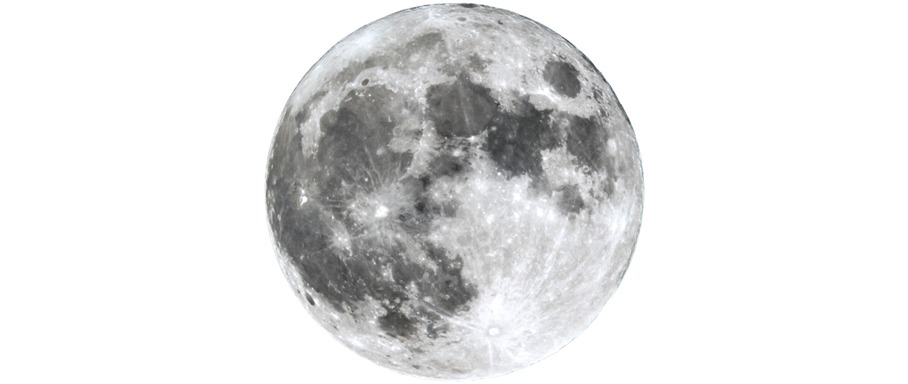

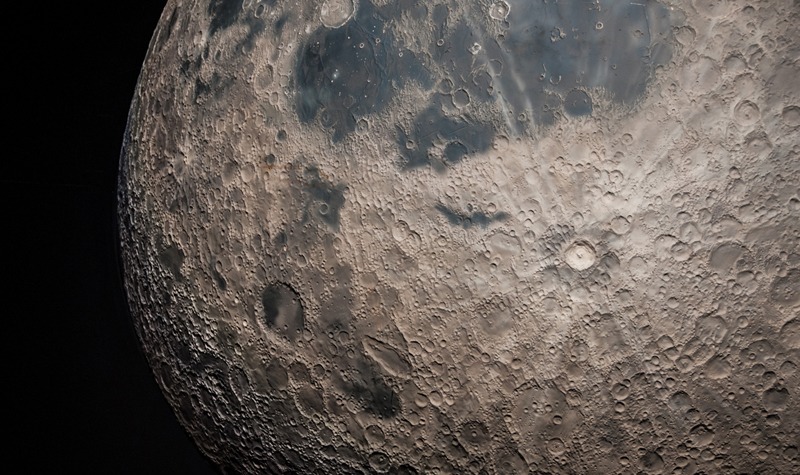
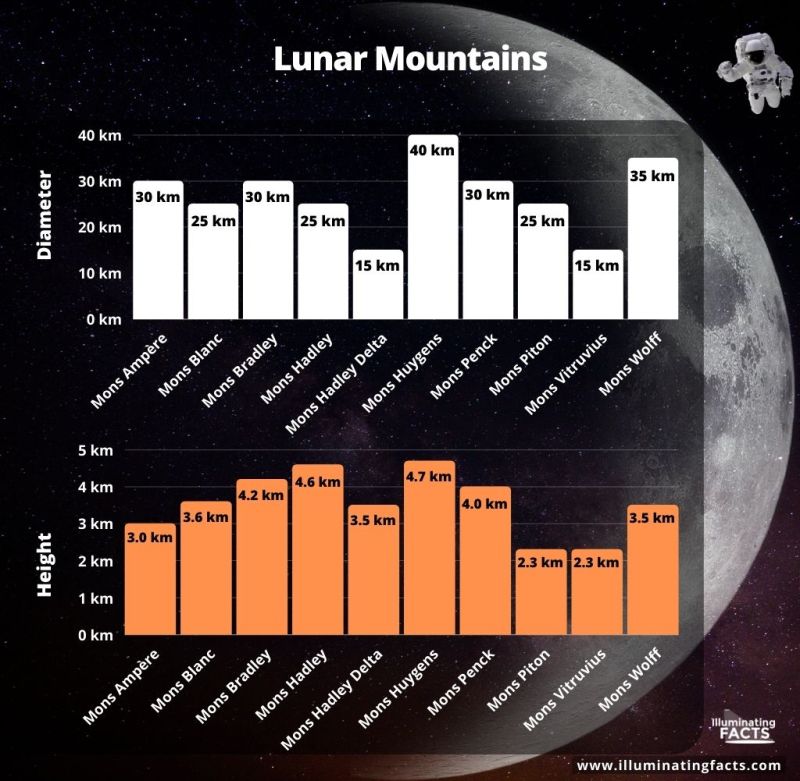
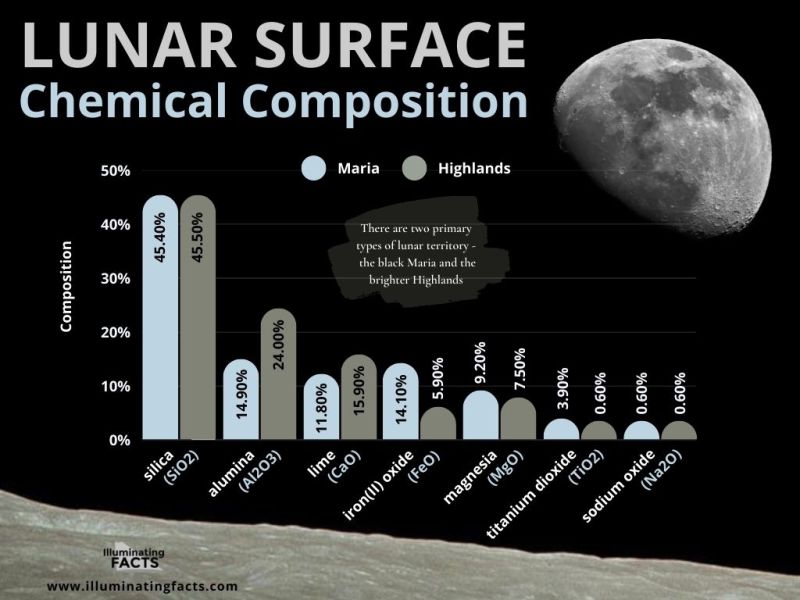
![3D illustration of sun covered by moon [eclipse] - Illuminating Facts full Solar eclipse](https://illuminatingfacts.com/wp-content/uploads/2021/12/full-Solar-eclipse.jpg)


